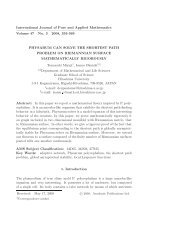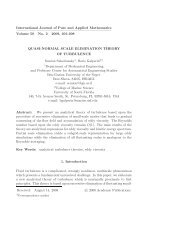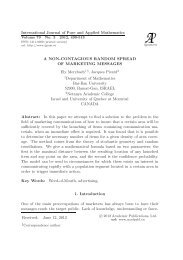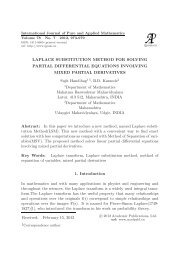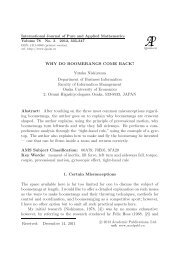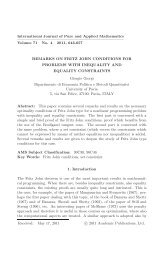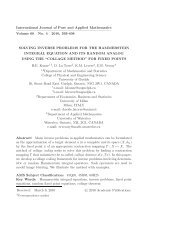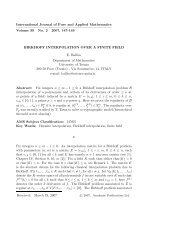FINDING N-TH ROOTS IN NILPOTENT GROUPS AND ...
FINDING N-TH ROOTS IN NILPOTENT GROUPS AND ...
FINDING N-TH ROOTS IN NILPOTENT GROUPS AND ...
You also want an ePaper? Increase the reach of your titles
YUMPU automatically turns print PDFs into web optimized ePapers that Google loves.
574 S. Sze, D. Kahrobaei, R. Dambreville, M. Dupas<br />
group is a ZA-group if and only if its upper central chain, possibly continued<br />
transfinitely, leads up to the group G.<br />
Lemma 2.4 (Grün’s Lemma). If a group G has a center Z(G) other than<br />
{1} and if the center of G/Z is also different from {1}, then there exists a<br />
homomorphic mapping of G onto a subgroup of Z(G) other than {1}.<br />
Proof. Let {1} Z1 Z2 · · · Zk · · · be the ascending central chain<br />
for G. Let a ∈ Z2\Z1 and x ∈ G. Note that since Z2/Z1 = Z(G/Z1), it follows<br />
that az1 commutes with xz ′ 1 for z1,z ′ 1 ∈ Z1 = Z(G). Let g ∈ G and z ∈ Z1.<br />
We compute<br />
[[a,x],g] = [a,x] −1 g −1 [a,x]g = x −1 a −1 xag −1 a −1 x −1 axg<br />
= (x −1 z)(a −1 z −1 )xag −1 a −1 x −1 axg<br />
= (a −1 z −1 )(x −1 z)xag −1 a −1 x −1 axg<br />
= g −1 a −1 x −1 axg<br />
= g −1 a −1 (x −1 z)(az −1 )xg<br />
= g −1 a −1 (az −1 )(x −1 z)xg<br />
= 1<br />
This shows that [a,x] ∈ Z1. Since a ∈ Z1, there exists y ∈ G such that<br />
[a,y] = 1. Now let ϕ : G → Z1 be defined by ϕ(x) = [a,x]. Clearly, ϕ is a<br />
nontrivial homomorphism from G to a subgroup of Z1.<br />
From this lemma, we can see that a non-commutative ZA-group contains a<br />
nontrivial abelian factor group and is therefore distinct from its derived group.<br />
Definition 2.5. A p−primary group is an abelian group in which the<br />
orders of all elements are powers of a fixed prime number p. An element a of a<br />
p−primary group G is said to be of infinite height if for every k the equation<br />
p k x = a has at least one solution in G. If this equation can be solved for k ≤ h,<br />
then we say the element a is an element of finite height, or of height h.<br />
We will state but not prove the following two theorems. For their proofs,<br />
we refer the reader to [9], pages 171 - 173.<br />
Theorem 2.6 (Kulikov’s Criterion). A primary abelian group G is a direct<br />
sum of cyclic groups if and only if it is the union of an ascending sequence of<br />
subgroups<br />
A (1) ≤ A (2) ≤ · · · A (n) ≤ · · ·<br />
such that the elements of each subgroup are of finite and bounded height in G.



